Kakadu National Park is one of Australia’s most iconic natural landscapes and is home to an incredible variety of bird species. From colorful parrots to majestic raptors, Kakadu is a bird watcher’s paradise, with over 280 different species recorded in the park.
The park’s range of habitats, from wetlands to monsoon forests, means that it is a great spot to see a variety of birds from all over Australia. Whether you’re a casual observer or a serious birder, Kakadu has something to offer everyone.
1. Black-necked Stork
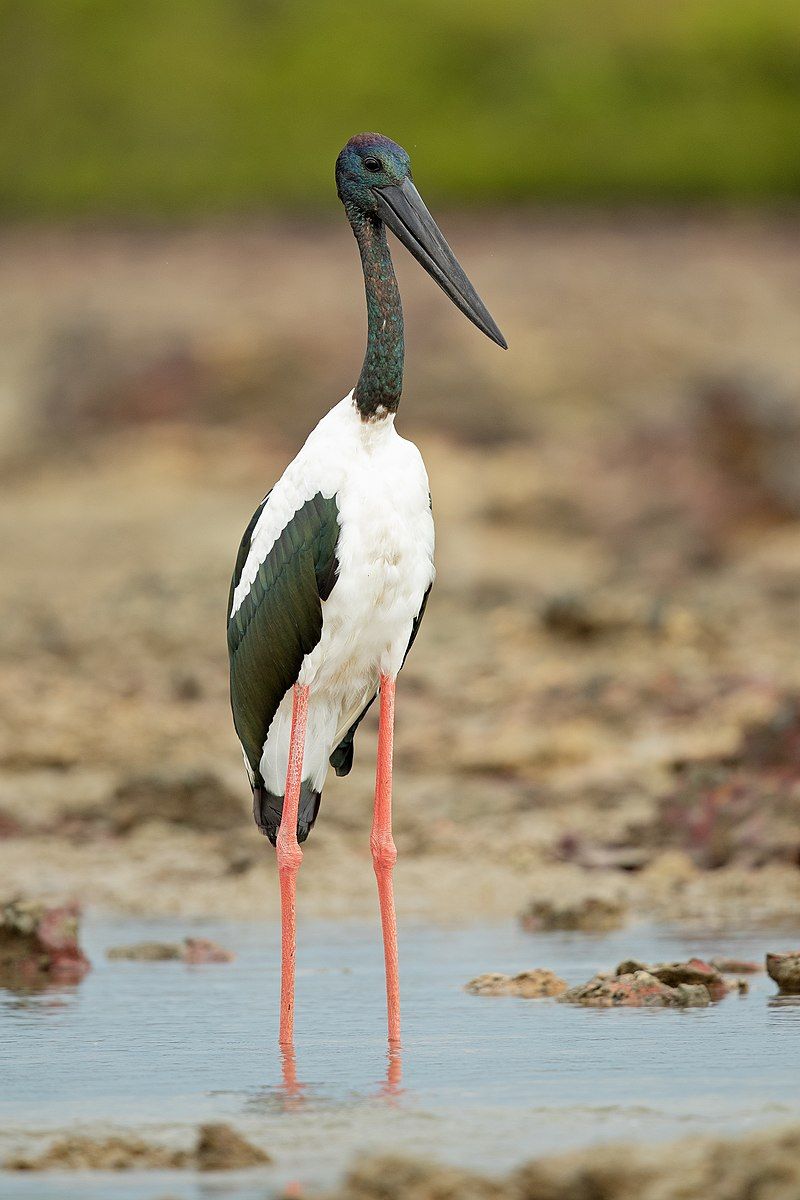
The black-necked stork is a species of wading bird belonging to the stork family. It is found in a wide range of habitats across the Indian Subcontinent and Southeast Asia, as well as in Australia, though the population there is considered to be disjunct.
These birds are relatively large, with long necks and legs. They breed in wetlands and marshy areas, and feed on fish, frogs, and other aquatic creatures. They are also known to raid the nests of other birds, snatching eggs and nestlings.
In some parts of its range, the black-necked stork is considered to be an endangered species due to loss of habitat, hunting, and disturbance from human activities.
Conservation efforts are underway to help protect this species, including the implementation of laws protecting their nesting sites.
| Kingdom | Animalia |
| Phylum | Chordata |
| Class | Aves |
| Order | Ciconiiformes |
| Family | Ciconiidae |
| Genus | Ephippiorhynchus |
| Species | E. asiaticus |
2. Magpie Goose
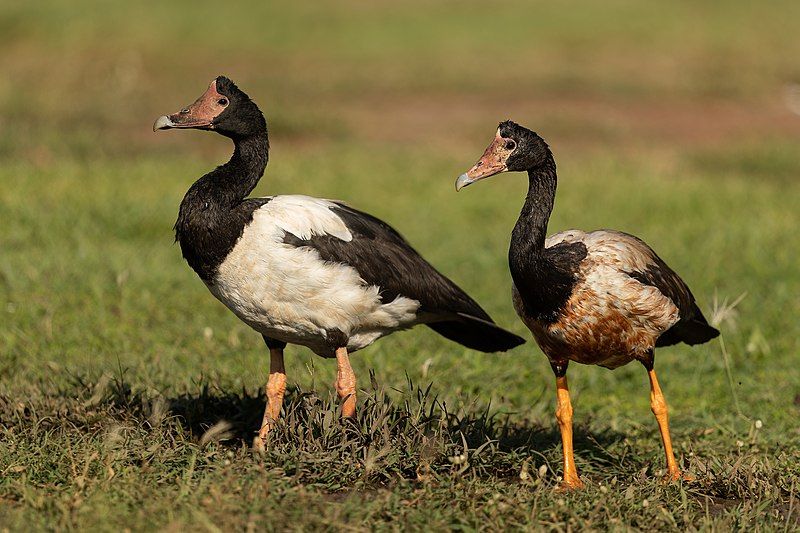
The Magpie Goose is an interesting bird that is found in northern Australia and southern New Guinea. It is the only surviving species of the family Anseranatidae, making it a rare and unique bird.
This common waterbird is a migratory species and is known for its tendency to wander, especially when it is not breeding.
As a result, it is sometimes seen outside of its normal range, which is why it is important to take note of any sightings of Magpie Geese outside of their core range.
Despite its wandering nature, the Magpie Goose is a resilient species and has managed to survive in its habitat for thousands of years. It is a beautiful bird, with striking black and white feathers and a distinct call.
The Magpie Goose is an important species, as it helps maintain the health of wetlands and other ecosystems in its habitat.
| Kingdom | Animalia |
| Phylum | Chordata |
| Class | Aves |
| Order | Anseriformes |
| Family | Anseranatidae |
| Genus | Anseranas |
| Species | A. semipalmata |
3. Orange-footed Scrubfowl
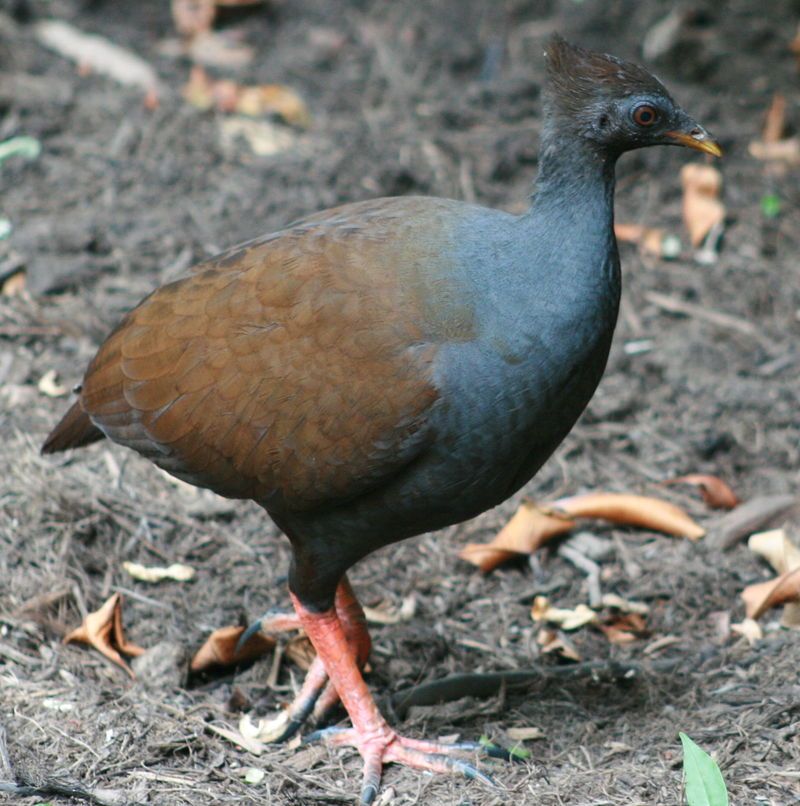
The orange-footed scrubfowl is a species of bird belonging to the family Megapodiidae. It is a small bird, typically measuring between 25 and 29 centimeters in length. It has distinct orange-colored feet which sets it apart from other members of the Megapodiidae family.
The orange-footed scrubfowl is native to many islands in the Lesser Sunda Islands, as well as southern New Guinea and northern Australia. This species of bird is also known as the orange-footed megapode or simply scrubfowl.
The orange-footed scrubfowl is found in open forests, woodland, and grassland habitats. It is omnivorous, meaning it feeds on both plants and animals. Its diet consists mostly of fruits, insects, and other small creatures.
This species of bird is also known for its unique nesting habits. Instead of building nests, it uses the heat of the sun and the earth to incubate its eggs. The eggs are buried in the ground and the heat of the sun and the earth will keep them warm until they hatch.
The orange-footed scrubfowl is considered to be of least concern according to the IUCN Red List of Threatened Species. However, due to the destruction of its natural habitat, its population is declining.
As a result, conservation efforts are necessary to ensure the survival of this species.
| Kingdom | Animalia |
| Phylum | Chordata |
| Class | Aves |
| Order | Galliformes |
| Family | Megapodiidae |
| Genus | Megapodius |
| Species | M. reinwardt |
4. Azure Kingfisher
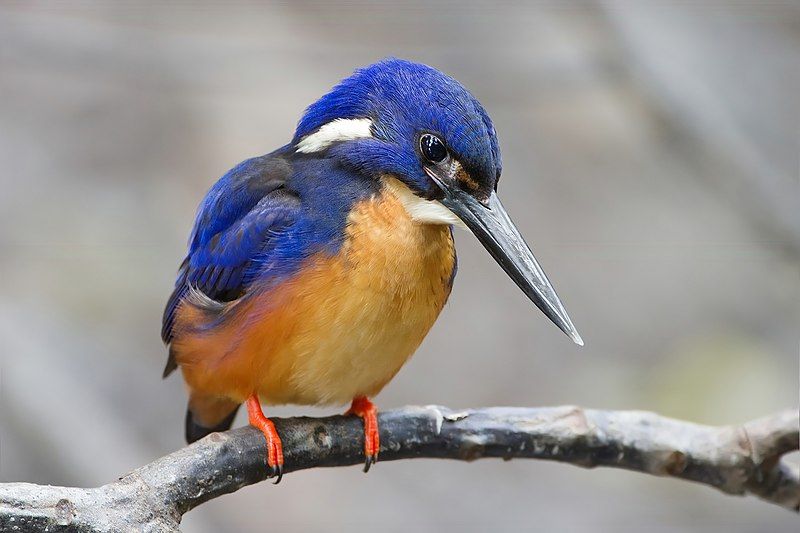
The azure kingfisher is a small species of kingfisher that belongs to the river kingfisher subfamily, Alcedininae. It is a member of the bird family Alcedinidae which contains all species of kingfishers.
The azure kingfisher is typically found in Australia, New Guinea, and the Solomon Islands. Its habitat includes swamps, rivers, lakes, and flooded grasslands.
It is a small, brightly colored bird that is typically blue-green in color with a yellow breast, white belly, and a black bill. Its wingspan ranges from 18-20 cm in length. The azure kingfisher is an expert fisher and is able to catch insects and small fish from the air.
It has a loud call that can be heard over long distances. The azure kingfisher is an important species for its ecosystem and helps to maintain balance in aquatic environments. It plays an important role in controlling insect populations, which can be a nuisance to humans.
Conservation efforts are necessary to protect the species and its habitat.
| Kingdom | Animalia |
| Phylum | Chordata |
| Class | Aves |
| Order | Coraciiformes |
| Family | Alcedinidae |
| Genus | Ceyx |
| Species | C. azureus |
5. Sandstone Shrikethrush
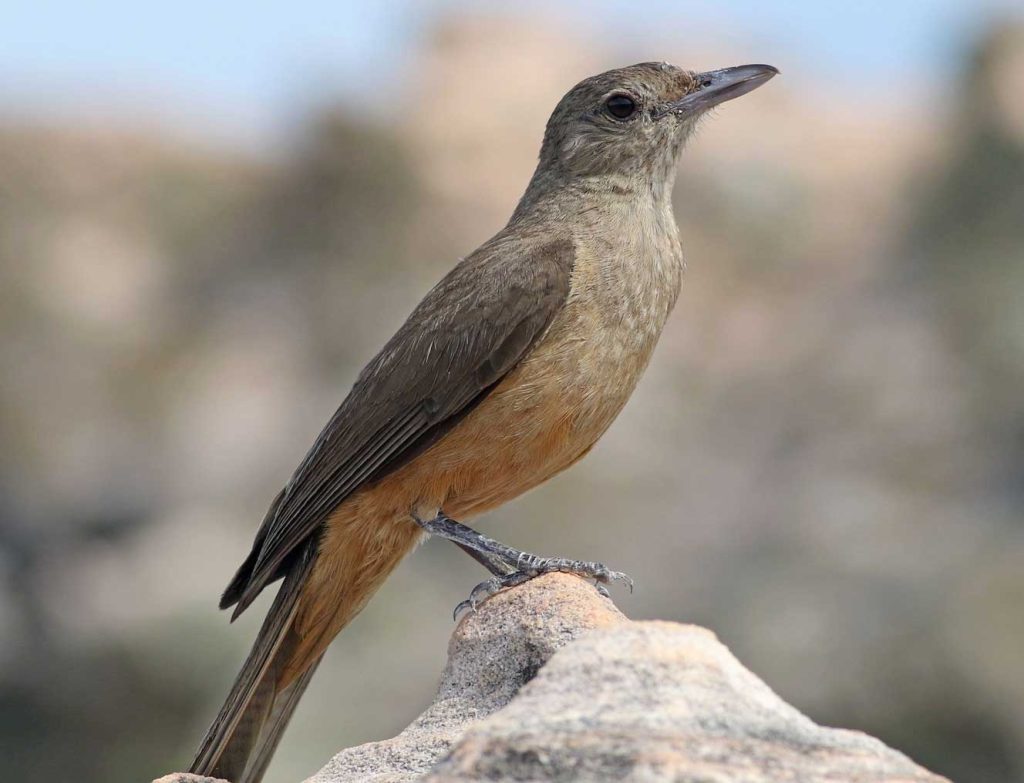
Source: ebird.org
The sandstone shrikethrush is a species of bird native to Australia. It is a member of the family Pachycephalidae, also known as shrike-thrushes. It is sometimes referred to by two alternate names: the brown-breasted shrike-thrush and the sandstone thrush.
The sandstone shrikethrush is a medium-sized bird, with a brown back and white underparts. Its most distinctive feature is the black eyestripe, which extends from the bill to the back of its head. It has a long, thin bill and a light brown crown.
The sandstone shrikethrush is found in a variety of habitats, such as open woodland, heathland, and grassland. It feeds mainly on insects and small invertebrates, and can sometimes be seen hawking for prey in the air.
The sandstone shrikethrush is a common species, and its population is stable.
| Kingdom | Animalia |
| Phylum | Chordata |
| Class | Aves |
| Order | Passeriformes |
| Family | Pachycephalidae |
| Genus | Colluricincla |
| Species | C. woodwardi |
6. Black-breasted Buzzard
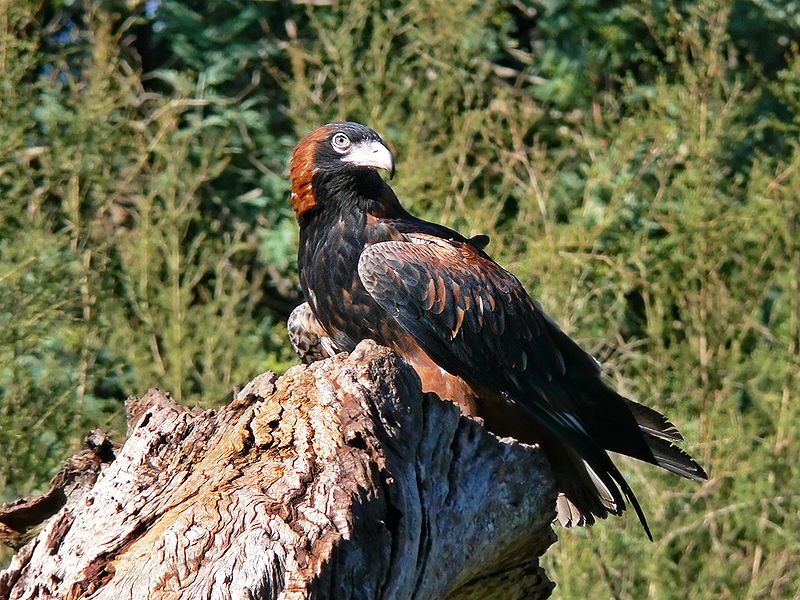
The black-breasted buzzard is a species of large raptor that is endemic to mainland Australia. It was first described by the famous English ornithologist John Gould in 1841.
The black-breasted buzzard is part of the family Accipitridae and is most closely related to the square-tailed kite.
It is a versatile hunter, distinguished by its special skill in cracking eggs. The black-breasted buzzard is a large bird with a wingspan of approximately 1.2 meters. It has a black-brown head and neck, and its wings, back, and tail are dark brown.
The underparts of the bird are white, with black and white stripes running across the chest. Its legs and feet are yellow. The black-breasted buzzard is a diurnal species, meaning it is most active during the day.
It hunts mainly small mammals, reptiles, amphibians, and insects, but is also known to eat carrion when available.
It is an adept hunter that can swoop down and capture its prey with its talons. The black-breasted buzzard is particularly adept at cracking eggs, giving it access to a valuable source of food.
It does this by grasping the egg in its talons and then smashing it against a hard surface, such as a rock or branch.
This technique is believed to be unique among raptors and is thought to have evolved as an adaptation to the bird’s arid habitat. Overall, the black-breasted buzzard is an impressive and unique species of raptor.
It is adapted to its environment in Australia and is a skilled hunter of small animals and eggs alike. Its special skill of cracking eggs makes it a valuable source of food for the species.
| Kingdom | Animalia |
| Phylum | Chordata |
| Class | Aves |
| Order | Accipitriformes |
| Family | Accipitridae |
| Genus | Hamirostra |
| Species | H. melanosternon |
7. Little Kingfisher
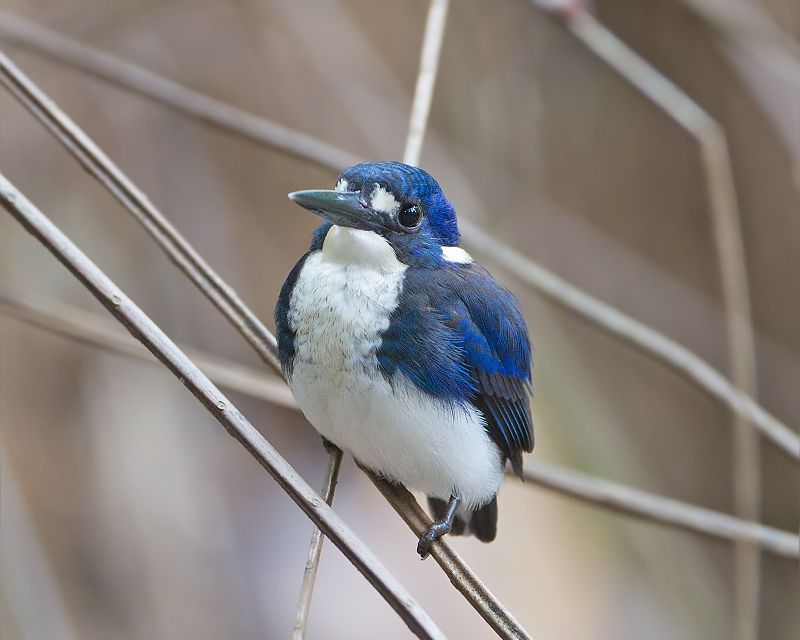
The little kingfisher is a small bird found in many parts of the world. It is part of the Alcedinidae family, which includes kingfishers, bee-eaters, and rollers.
This species of kingfisher is found in the subfamily Alcedininae, which is the smallest subfamily of the larger family. The little kingfisher is known for its vibrant blue-green feathers, its long slender bill, and its short legs.
It lives near water, where it can feed on insects, small fish, and crustaceans. It is most active in the late afternoon when it searches for prey. The little kingfisher is a solitary creature, but sometimes it will gather in small groups to search for food.
It is an important indicator of a healthy waterway, and its presence is a sign of a thriving ecosystem.
| Kingdom | Animalia |
| Phylum | Chordata |
| Class | Aves |
| Order | Coraciiformes |
| Family | Alcedinidae |
| Genus | Ceyx |
| Species | C. pusillus |
8. Nankeen Night Heron
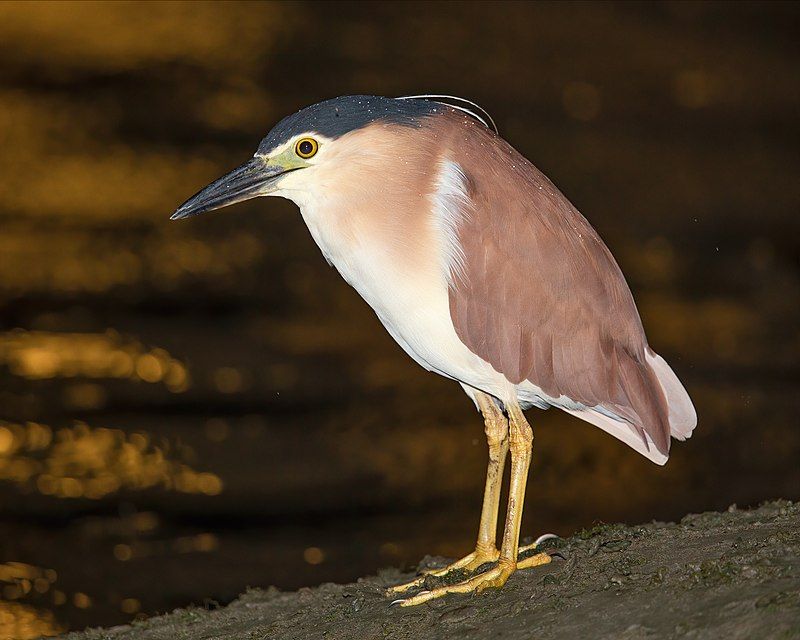
The nankeen night heron is a type of heron that belongs to the genus Nycticorax and the family Ardeidae. The nankeen night heron is easily identifiable by its distinct reddish-brown color, which has earned the bird the nickname of the rufous night heron.
It is a medium-sized heron, measuring between 48 and 56 cm in length, with a wingspan of 76 to 90 cm. The bird has an overall greyish-brown hue, and the feathers on its back, wings, and head are darker than those on its belly.
Its bill is black, and its legs are yellow, with yellow feet. The nankeen night heron is found throughout Australia, in areas with freshwater wetlands and reed beds. It is usually found alone or in small groups and is most active during the night and early morning hours.
The bird feeds on small fish, crustaceans, frogs, snakes, and insects.
It perches on low branches in order to observe its prey, before swooping down to catch it. The nankeen night heron is classified as a species of least concern on the International Union for Conservation of Nature and Natural Resources (IUCN) Red List.
This is due to its wide distribution and stable population. However, the species is threatened by habitat degradation and loss, pollution, and predation by domestic cats. As such, conservation efforts are in place to protect the species and its habitat.
| Kingdom | Animalia |
| Phylum | Chordata |
| Class | Aves |
| Order | Pelecaniformes |
| Family | Ardeidae |
| Genus | Nycticorax |
| Species | N. caledonicus |
9. White-throated Grasswren
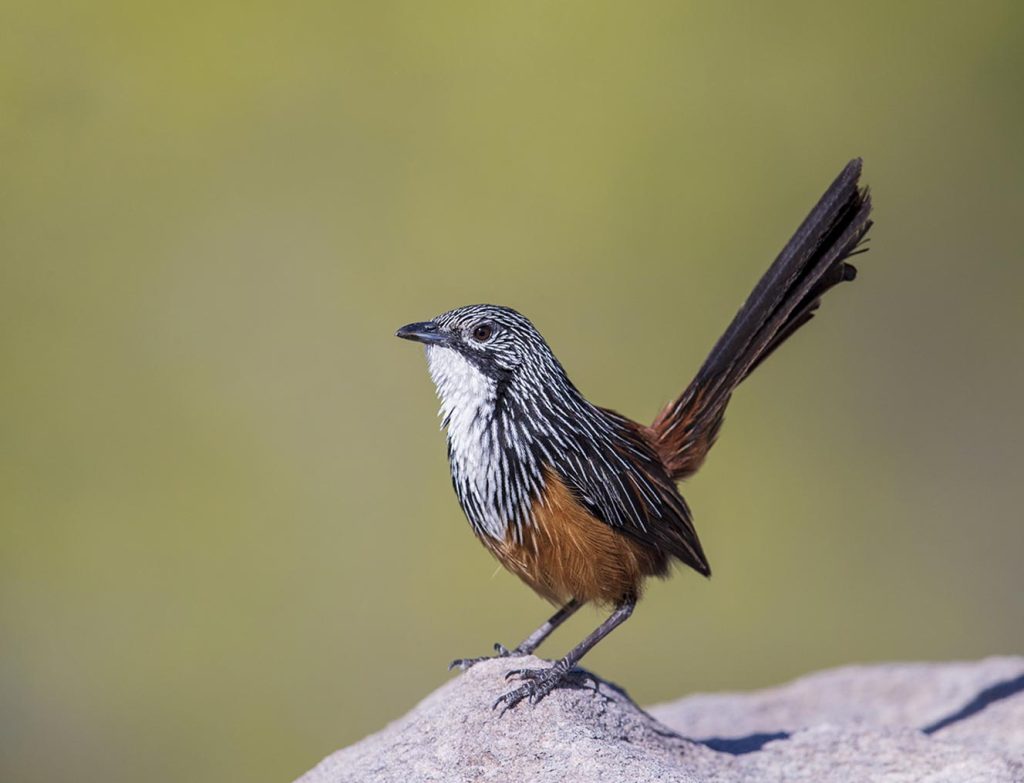
Source: tracksbirding.com.au
The white-throated grasswren is an intriguing species of bird in the family Maluridae. It is only found in a very specific region of Australia, an area known as West Arnhem Land in the Northern Territory. It is an endemic species, meaning it is found nowhere else in the world.
The local Aborigines have even given it its own name: Yirlinkirrkirr. This type of bird is quite small in size, measuring around 10 to 12 cm in length, and usually a brownish-grey color with some white and black markings.
It has a distinctive white throat patch, which is where it gets its name. It is usually found in the grasslands, scrubland, or woodlands of the region.
It is a very shy and skittish bird, so it can be difficult to spot in the wild. The white-throated grasswren is listed as Vulnerable on the IUCN Red List, due to its limited range and the threats posed by habitat destruction and degradation.
Conservation efforts are underway to protect this species and its habitat, in order to ensure its long-term survival.
| Kingdom | Animalia |
| Phylum | Chordata |
| Class | Aves |
| Order | Passeriformes |
| Family | Maluridae |
| Genus | Amytornis |
| Species | A. woodwardi |
10. Rainbow Bee-eater
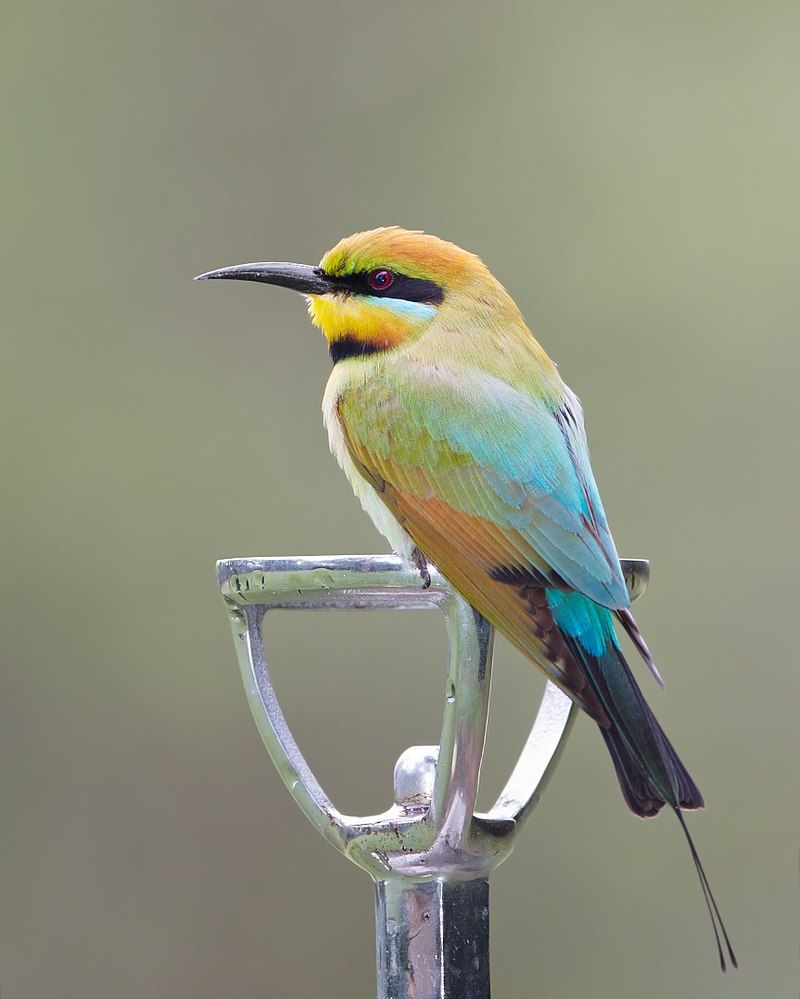
The rainbow bee-eater (Merops ornatus) is a beautiful near-passerine bird found in the bee-eater family Meropidae. It is easily recognizable thanks to its colorful plumage, which features iridescent shades of blue, green, and red.
This species is found in a wide range of habitats, including woodlands, grasslands, and even near water.
They are medium-sized birds, typically measuring between 17 and 19 cm in length. Rainbow bee-eaters are insectivorous, and they mainly feed on flying insects like bees and wasps.
They catch their prey in mid-air, by quickly darting out from a perch and snatching them before returning to the same spot.
They also have a unique foraging technique, known as “aerial hawking”, where they fly up into the air and circle around an area to catch their prey. These birds are monogamous, and they often form close pair bonds that last for several breeding seasons.
They are also highly social, and they often form large flocks of hundreds of birds. During the breeding season, they construct nest tunnels in the ground, usually near water sources.
They lay between two and four eggs, which are incubated by both parents for about two weeks. Rainbow bee-eaters are a common species throughout their range, and they are not considered to be threatened.
However, their numbers may be declining due to habitat destruction and the effects of climate change.
| Kingdom | Animalia |
| Phylum | Chordata |
| Class | Aves |
| Order | Coraciiformes |
| Family | Meropidae |
| Genus | Merops |
| Species | M. ornatus |
11. Plumed Whistling Duck
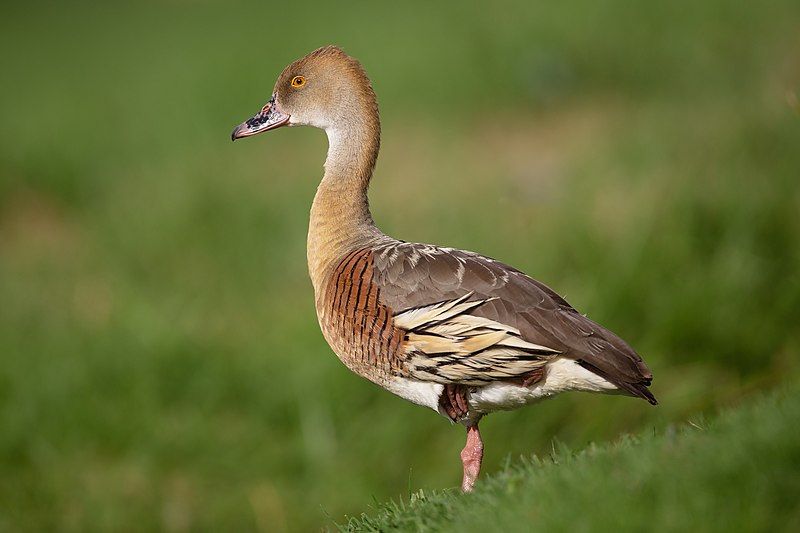
The plumed whistling duck is a species of duck native to Australia. It is also known as the grass-whistling duck. This species has a distinct appearance, featuring a long neck and prominent plumes or feathers that arise from its flanks.
Both the male and the female look alike, with predominantly brown coloring. The plumed whistling duck is a relatively small species of duck and is easily identified by its unique whistling sound.
It is a social species that often gather in large flocks, and it has a wide range of habitats, from wetlands to open grasslands. It is an omnivore, feeding on seeds, plant material, and small invertebrates.
The plumed whistling duck is an important part of Australia’s ecosystem, and it plays an important role in controlling the population of aquatic insects.
| Kingdom | Animalia |
| Phylum | Chordata |
| Class | Aves |
| Order | Anseriformes |
| Family | Anatidae |
| Genus | Dendrocygna |
| Species | D. eytoni |
12. Australasian Darter
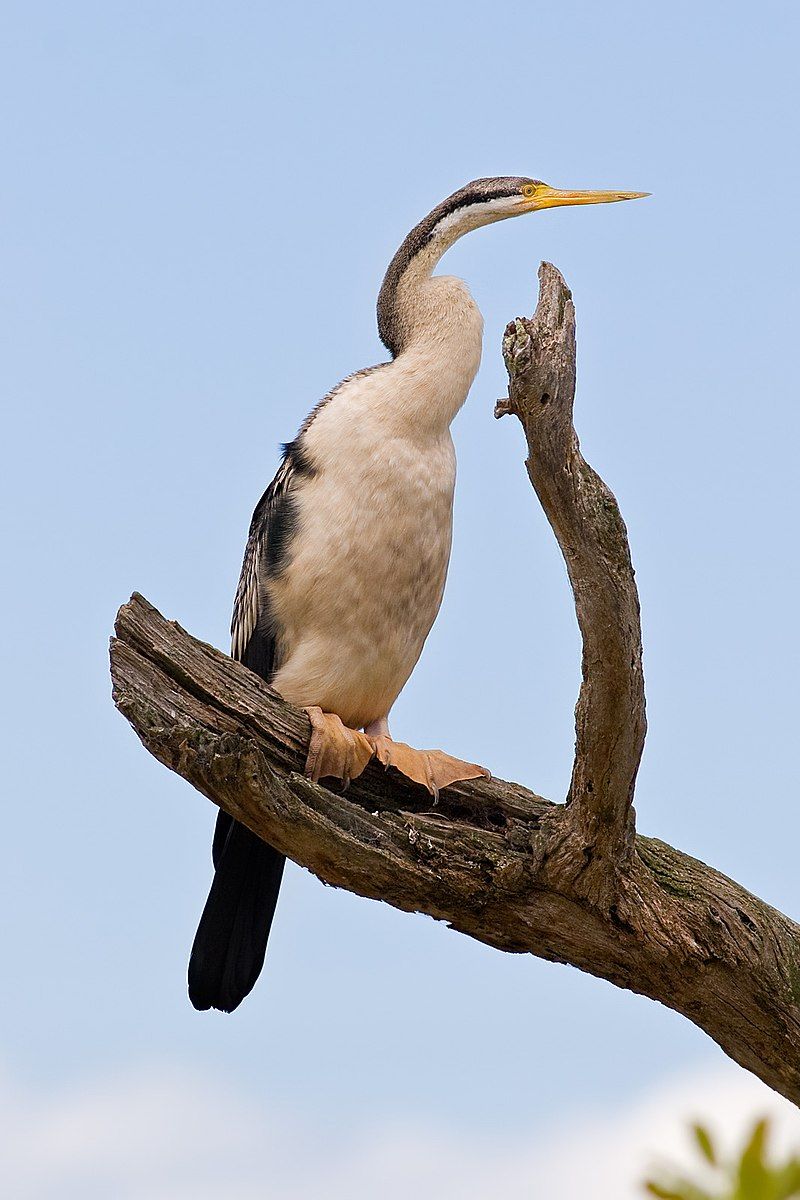
The Australasian darter, or Australian darter, is a species of bird found in Australia, Indonesia, and Papua New Guinea. It belongs to the family of birds known as Anhingidae, which are commonly referred to as darters.
This species of bird is known for its large size, weighing approximately 2.6 kg and spanning between 86-94 cm in length. It is a unique species in that it is one of the few birds in the Anhingidae family which is found in Australia.
The bird has an overall brownish-green coloration, with a whiteish underside that helps it blend in with its environment. Its large size makes it well-suited for diving and fishing, which is its main source of food.
It spends most of its time in shallow, brackish waters, making it an important species for the local ecosystem. Its long beak and neck are adapted for spearfishing, enabling it to catch small fish and crustaceans with ease.
Its wings are strong and powerful, allowing it to fly long distances and migrate between the countries in which it is found.
The Australasian darter is an important species for the local ecosystems in which it lives, as its presence helps to maintain balance in the local food chain.
Its fishing and diving activities provide a food source for other species, and its presence helps to control the population of certain fish and crustaceans. It’s large size and long wings also provide a great opportunity for birdwatchers to observe and appreciate its beauty.
| Kingdom | Animalia |
| Phylum | Chordata |
| Class | Aves |
| Order | Suliformes |
| Family | Anhingidae |
| Genus | Anhinga |
| Species | A. novaehollandiae |
13. Great Bowerbird
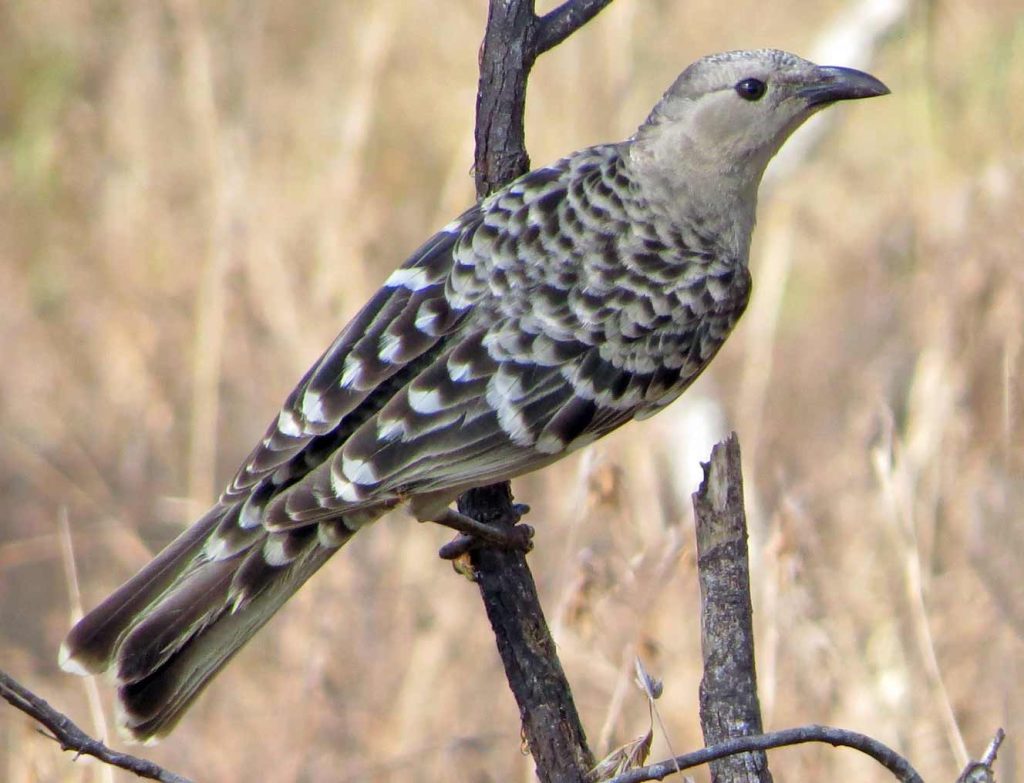
Source: ebird.org
The great bowerbird is a species of bird native to Australia and is found in the northern parts of the country.
It is a common and easily seen bird, living in a variety of habitats from the area around Broome in the west, across the Top End of the Northern Territory, and as far south as Mount Isa in Queensland. The great bowerbird prefers a wide range of forests and woodlands, such as those found on the edges of vine forests, monsoon forests, and mangrove swamps.
The bird has adapted to these different environments, making its home in the trees and shrubs of its surroundings.
Its diet consists of a variety of foods, including insects, seeds, and fruit. The great bowerbird is an important species in Australia, as it helps to maintain the balance of the environment.
Its presence in forests and woodlands helps to keep the trees and shrubs healthy, and its diet helps to control the populations of insects and other small animals. The great bowerbird is also recognized as a cultural symbol in many Aboriginal communities, where it is often seen as a symbol of strength and survival.
The bird is seen as an important part of the environment, and its presence is seen as a sign of the land’s health and abundance.
| Kingdom | Animalia |
| Phylum | Chordata |
| Class | Aves |
| Order | Passeriformes |
| Family | Ptilonorhynchidae |
| Genus | Chlamydera |
| Species | C. nuchalis |
14. Masked Finch
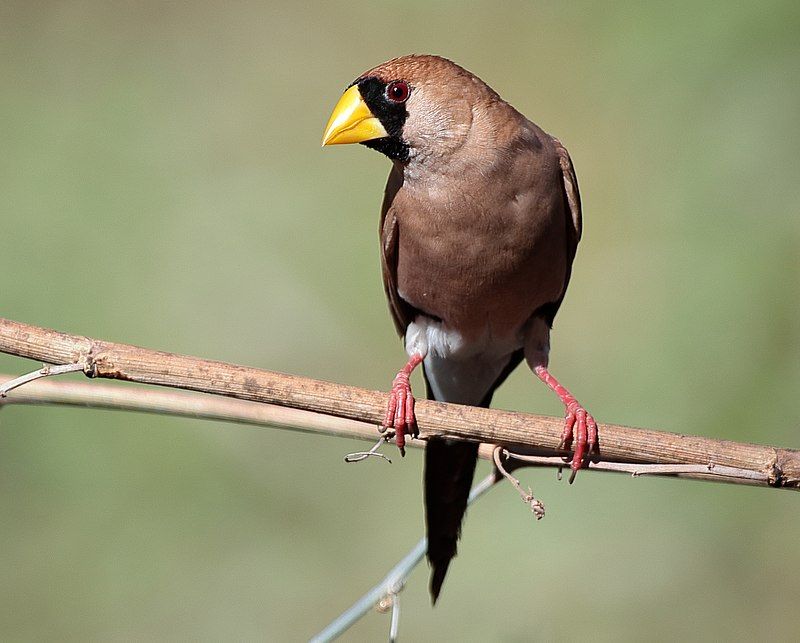
The masked finch is a small species of bird belonging to the family Estrildidae, commonly known as estrildid finches. It is native to dry savannah habitats across Northern Australia, from the Kimberley region in the west to the Cape York Peninsula in the east.
This species is often found in areas with limited water resources, as well as near rivers and other sources of water. As a result, it is an excellent adaptor to its environment and is able to survive in harsh conditions.
The masked finch is a common resident of these areas, including the Top End, the Gulf Country, and Chillagoe. It is a colorful and lively species with a wide range of vocalizations and is a popular pet bird in certain areas.
| Kingdom | Animalia |
| Phylum | Chordata |
| Class | Aves |
| Order | Passeriformes |
| Family | Estrildidae |
| Genus | Poephila |
| Species | P. personata |
15. Rainbow Pitta
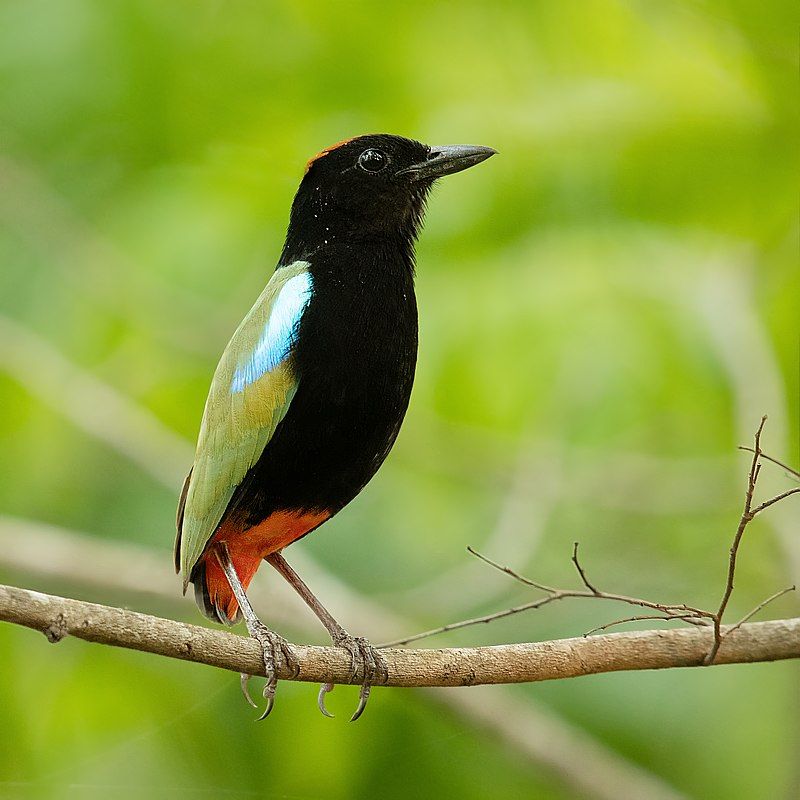
The Rainbow Pitta is a small passerine bird, meaning it is a type of perching bird, that belongs to the Pittidae family. It is native only to northern Australia and is closely related to the Superb Pitta of Manus Island.
The Rainbow Pitta has an interesting plumage, with a velvet black head sporting chestnut-colored stripes above the eyes, olive green upper parts, black underparts, a bright red belly, and an olive green tail.
The bright colors of this bird make it a very attractive sight, and it is a popular bird to watch among bird-watchers. The Rainbow Pitta is mainly found in rainforest and wetter woodlands, where it feeds on insects, worms, and small fruits.
It spends the majority of its time in the understory of the forest, making it a challenge to spot. However, it can be seen in the early morning or late afternoon, when it is more active.
| Kingdom | Animalia |
| Phylum | Chordata |
| Class | Aves |
| Order | Passeriformes |
| Family | Pittidae |
| Genus | Pitta |
| Species | P. iris |
16. Little Friarbird
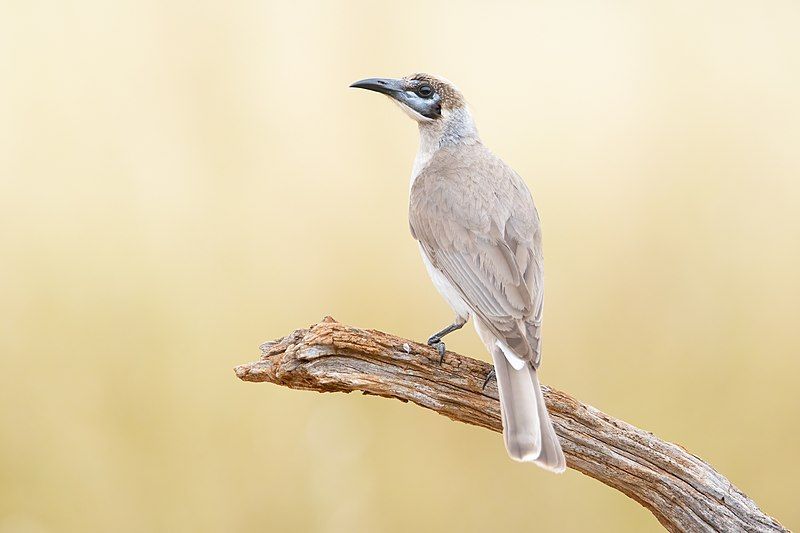
The Little Friarbird, scientifically known as the Philemon genus, is a species of bird native to Australia and Papua New Guinea. It is the smallest of the friarbird species and is easily distinguishable by its yellow throat.
It is often referred to as the “Little Leatherhead” or the “Yellow-throated Friarbird” due to its unique coloring. The Little Friarbird is found throughout northern and eastern Australia, including Queensland, New South Wales, and the Northern Territory, as well as in Southern Papua New Guinea.
It prefers to inhabit open woodlands and savannas, particularly near water. The Little Friarbird feeds on insects, nectar, berries, and other fruits. It typically forages in pairs or small groups, and will often join other bird species in the pursuit of food.
It has a loud, high-pitched call that is often referred to as a “buzzing” sound. The Little Friarbird is generally considered to be an insectivore, though it has been observed feeding on fruits and berries as well.
It is an important part of the local ecology, helping to keep insect populations in check while providing food for other bird species.
It is also an important pollinator for many native plants in its habitat. The Little Friarbird is a unique and important species, holding a significant place in the local ecology of its native Australia and Papua New Guinea.
Its small size and yellow throat make it easily recognizable, and its loud call is often heard in the bush. It is a valuable species in the local environment, providing food and pollination services that are essential for the health of the surrounding ecosystems.
| Kingdom | Animalia |
| Phylum | Chordata |
| Class | Aves |
| Order | Passeriformes |
| Family | Meliphagidae |
| Genus | Philemon |
| Species | P. citreogularis |
17. Lemon-bellied Flyrobin
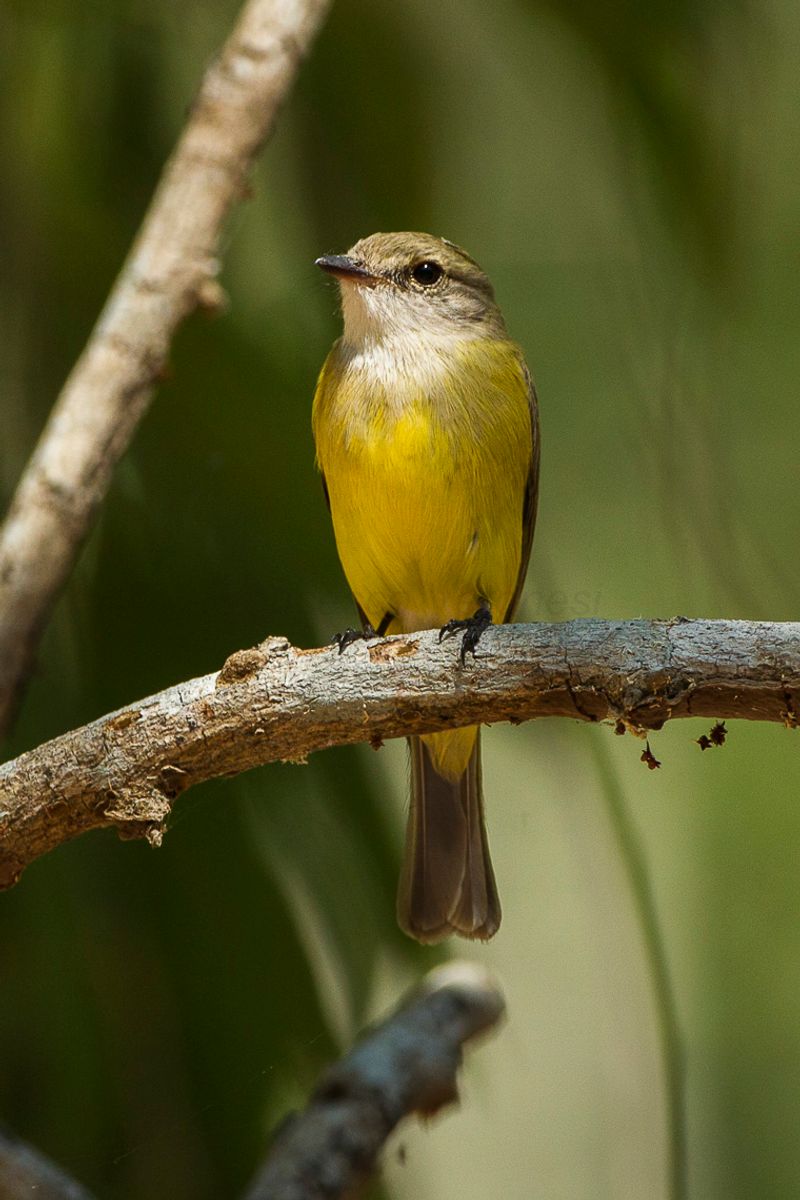
The lemon-bellied fly robin or lemon-bellied flycatcher is a species of bird found in Australia, Indonesia, and Papua New Guinea. It belongs to the family Petroicidae, which is a family of small passerine birds native to Australasia and the Indomalaya ecozone.
The bird’s natural habitats are subtropical or tropical moist lowland forests and subtropical or tropical mangrove forests.
These forests provide the bird with the necessary habitat requirements for food, water, and shelter. The lemon-bellied fly robin feeds mainly on insects but also consumes other invertebrates and some fruit.
They are usually found in pairs or small groups and often perch on low branches at the edge of forests. The lemon-bellied flycatcher is a monogamous species, with pairs staying together for the breeding season.
The female usually lays 3-4 eggs in a nest made in a tree branch or other elevated area.
The chicks are born blind and featherless and are cared for by both parents until they are ready to leave the nest. The lemon-bellied fly robin is listed as a species of Least Concern by the International Union for Conservation of Nature and Natural Resources (IUCN).
This is due to its wide distribution and stable population. Despite this, the species is affected by habitat loss due to deforestation and logging activities. To help protect the lemon-bellied fly robin, conservation efforts should focus on protecting the bird’s natural habitats.
This can include the establishment of protected areas, the implementation of sustainable forestry practices, and the restoration of degraded forests.
| Kingdom | Animalia |
| Phylum | Chordata |
| Class | Aves |
| Order | Passeriformes |
| Family | Petroicidae |
| Genus | Microeca |
| Species | M. flavigaster |
18. Rufous Whistler
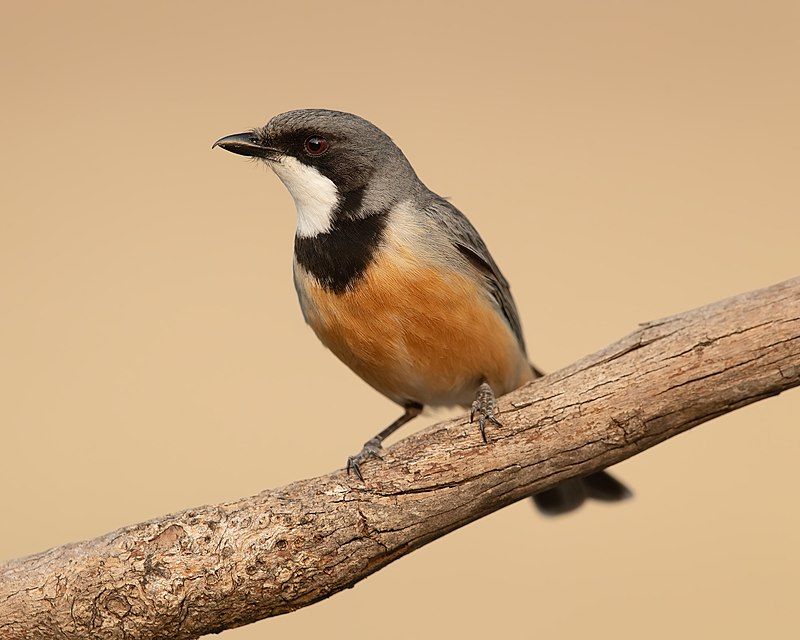
The Rufous Whistler is a species of bird from the family Pachycephalidae that is native to both New Caledonia and Australia. It is easily recognizable due to its distinctive reddish-brown and grey plumage.
Despite its relatively dull colors, the Rufous Whistler is one of the most vocal birds in the Pachycephalidae family and is renowned for its impressive song-making ability. It has a wide variety of musical calls, from high-pitched cries to deep, melodic chirps.
This impressive vocal range makes it a popular bird to observe for both birdwatchers and casual observers alike.
| Kingdom | Animalia |
| Phylum | Chordata |
| Class | Aves |
| Order | Passeriformes |
| Family | Pachycephalidae |
| Genus | Pachycephala |
| Species | P. rufiventris |
19. Horsfield’s Bronze Cuckoo
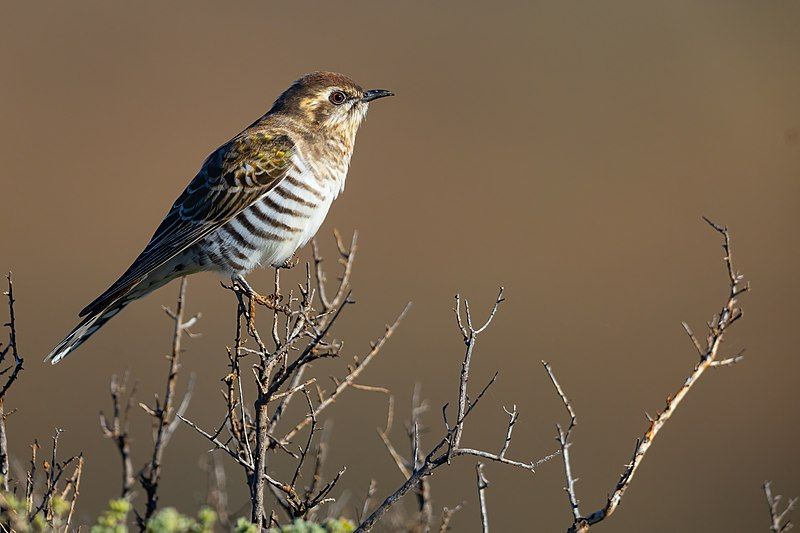
Horsfield’s bronze cuckoo is a species of small cuckoo belonging to the family Cuculidae. It is a relatively small bird, with an average weight of 22 grams, and is easily recognizable by its distinctive coloration.
The back of the bird has a brilliant green and bronze iridescent sheen, while its underside is dappled with incomplete brown barring from neck to tail. This coloration is unique to Horsfield’s bronze cuckoo and helps to differentiate it from other species of cuckoo.
The Horsfield’s bronze cuckoo is found across Southeast Asia in countries such as Thailand, Myanmar, and Laos. Its preferred habitat is tropical forests and woodlands, where it primarily feeds on insects, lizards, and small frogs.
It is known to be a shy and elusive bird and is rarely seen in the open. Horsfield’s bronze cuckoo is listed as a species of Least Concern on the International Union for Conservation of Nature (IUCN) Red List. This is due to its large range and stable population.
However, its habitat is being increasingly threatened by human activities, such as deforestation and agricultural expansion.
As a result, it is important to ensure that its habitat is protected and preserved, in order to ensure that this species can thrive for generations to come.
| Kingdom | Animalia |
| Phylum | Chordata |
| Class | Aves |
| Order | Cuculiformes |
| Family | Cuculidae |
| Genus | Chrysococcyx |
| Species | C. basalis |
20. Masked Woodswallow
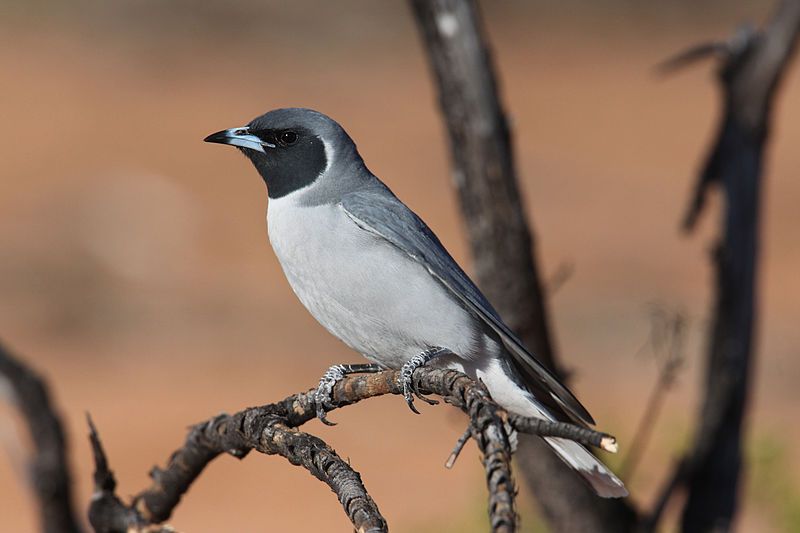
The Masked Woodswallow is a species of bird belonging to the Artamidae family. The family is made up of smaller bird species living in Australia and the surrounding islands, New Guinea and the Solomon Islands.
The Masked Woodswallow lives mainly in the eastern and northern parts of Australia and is found in small groups that move together in search of food.
They feed mainly on insects, fruits, and nectar from flowering plants. The Masked Woodswallow is a small bird, with a wingspan of about 21 cm and a body length of around 13 cm. It is mainly grey in color, with a pale yellow belly and a distinctive black mask across its face.
Its long, pointed bill is black, and its legs are short and strong. The Masked Woodswallow is an active and acrobatic bird, often seen flying in flocks and performing complex aerial maneuvers.
During the breeding season, it builds its nest out of grass and twigs in the forks of trees and lays two to three eggs.
It is a social species, and can often be seen in flocks of up to forty individuals. The Masked Woodswallow is classified as a species of least concern by the IUCN. They are not threatened by habitat loss, and their population is stable.
However, they may be vulnerable to climate change, as their range is limited by the availability of food.
| Kingdom | Animalia |
| Phylum | Chordata |
| Class | Aves |
| Order | Passeriformes |
| Family | Artamidae |
| Genus | Artamus |
| Species | A. personatus |
21. Great-billed Heron
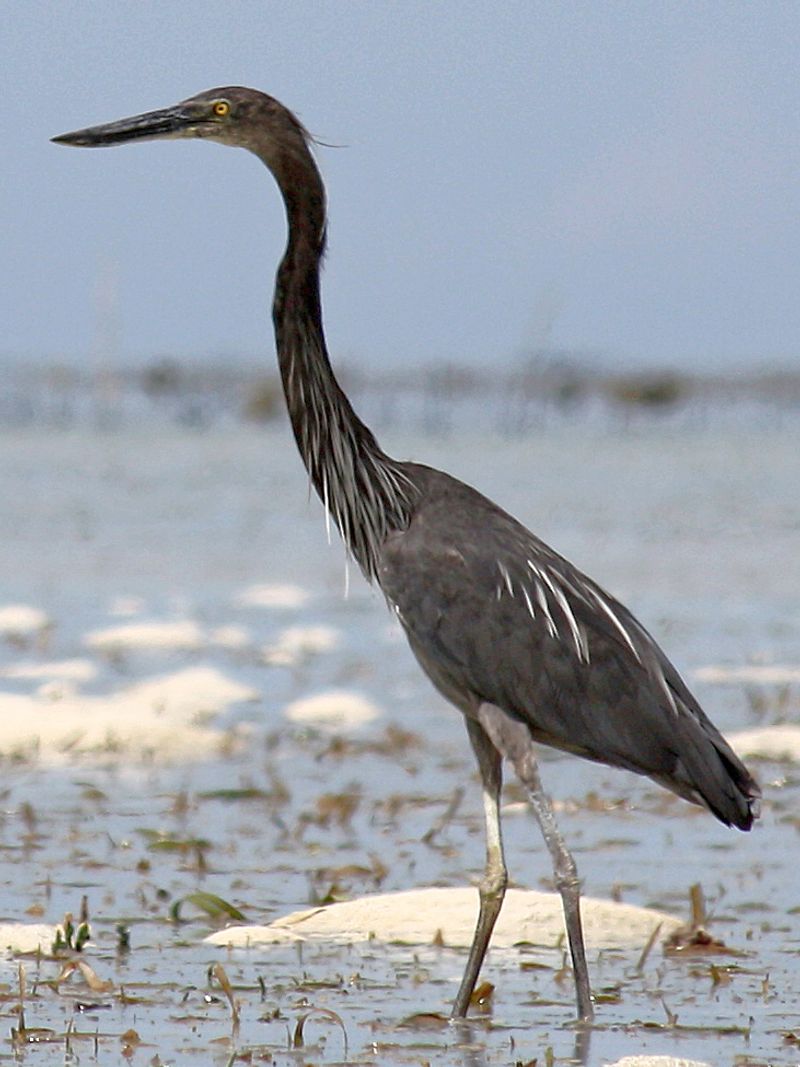
The great-billed heron is a remarkable bird that belongs to the heron family.
It is found in the wetlands of Southeast Asia, including countries such as Thailand, Indonesia, and Malaysia, and also in Papua New Guinea and Australia. This majestic bird stands at a height of up to three feet and boasts a long, sharp bill.
Its plumage colors vary, but usually include shades of white, gray, brown, and black. Its long neck and slim body give it a graceful, elegant appearance. The great-billed heron is typically a solitary bird. It feeds on small fish, frogs, crustaceans, and insects.
It is usually found near water, or along the shorelines of rivers, estuaries, and wetlands. The great-billed heron is an important indicator species in wetlands.
Its presence is an indication that the wetland is healthy and undisturbed and can provide important habitat for other species. Unfortunately, this species is threatened by habitat destruction and pollution.
Its numbers have decreased in recent years, and it is now listed as Vulnerable by the IUCN. Conservation efforts are essential to ensure that this species is able to survive and thrive in its natural habitat.
| Kingdom | Animalia |
| Phylum | Chordata |
| Class | Aves |
| Order | Pelecaniformes |
| Family | Ardeidae |
| Genus | Ardea |
| Species | A. sumatrana |
22. Chestnut-backed Buttonquail
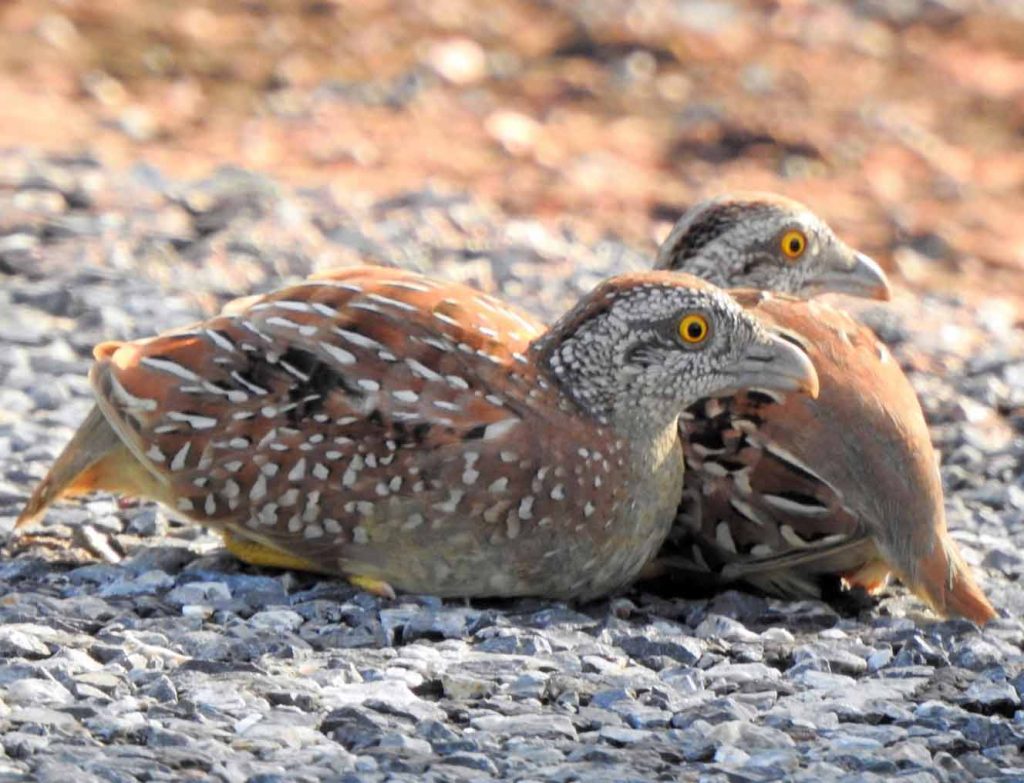
The chestnut-backed buttonquail is a small species of bird found only in Australia. It belongs to the family Turnicidae, which contains a variety of species of quail found across the world.
This particular species is found in a variety of habitats including open woodland, savanna, and grassland areas. It is a ground-dwelling bird, living and foraging for food on the ground.
Its diet consists mainly of seeds and insects. The chestnut-backed buttonquail is a distinctive species, with its chestnut back and white underparts. This species is monogamous, with both parents caring for the young.
The breeding season usually begins in late winter and the female will lay two to three eggs in a shallow scrape in the ground. The chicks are born precocial, meaning they are ready to leave the nest soon after hatching.
The chestnut-backed buttonquail is currently listed as a species of least concern on the IUCN Red List. This means that the species is not in immediate danger of extinction. However, their population is declining due to the destruction of their natural habitat.
Conservation efforts are needed to ensure the continued survival of this species.
| Kingdom | Animalia |
| Phylum | Chordata |
| Class | Aves |
| Order | Charadriiformes |
| Family | Turnicidae |
| Genus | Turnix |
| Species | T. castanotus |
23. Striated Pardalote
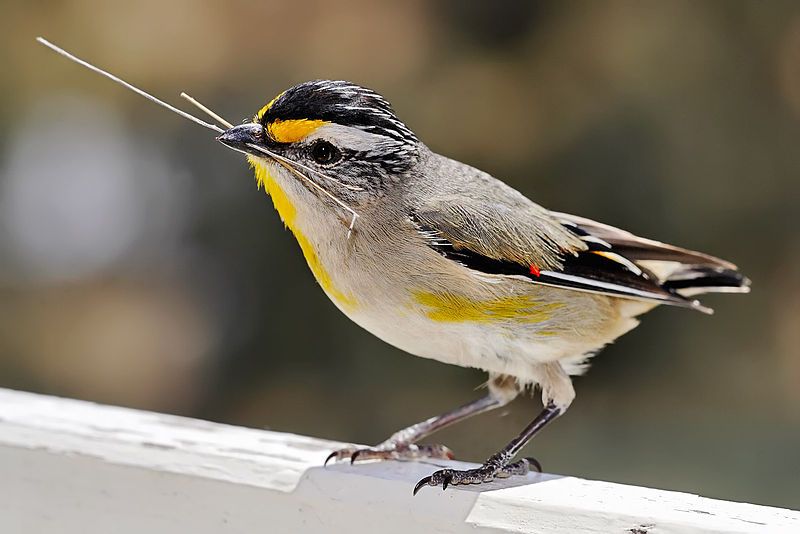
The striated pardalote is a small bird native to Australia and is known by many other names such as Pickwick, witches, and chip-chip. It is the least colorful and most common of the four pardalote species. Due to its small size and short tail, it is more often heard than seen.
It is a very active bird, foraging noisily for lerps and other small creatures in the treetops. The striated pardalote is a small bird with a plump body and short tail. Its plumage is mostly grey and white with black stripes, giving it the name “striated”.
It has a short, sharp, and distinctive call that can be heard from some distance.
It has a preference for the canopy of open eucalypt forests and woodland habitats.The striated pardalote is an omnivore, and its diet consists of lerps, small insects, and other small invertebrates.
It is an active forager, making short flights from tree to tree and searching for food while clinging to the bark.
The striated pardalote can also be seen hovering to pick food from the leaves, or hovering over a branch and flicking its tail. In conclusion, the striated pardalote is the least colorful and most common of the four pardalote species.
It is a small and active bird, more often heard than seen, foraging noisily for lerps and other small creatures in the treetops. Its diet is mainly composed of lerps, small insects, and other small invertebrates.
It is a very interesting bird and well worth keeping an eye and ear out for the next time you go for a walk in the bush.
| Kingdom | Animalia |
| Phylum | Chordata |
| Class | Aves |
| Order | Passeriformes |
| Family | Pardalotidae |
| Genus | Pardalotus |
| Species | P. striatus |
24. White-bellied Cuckooshrike
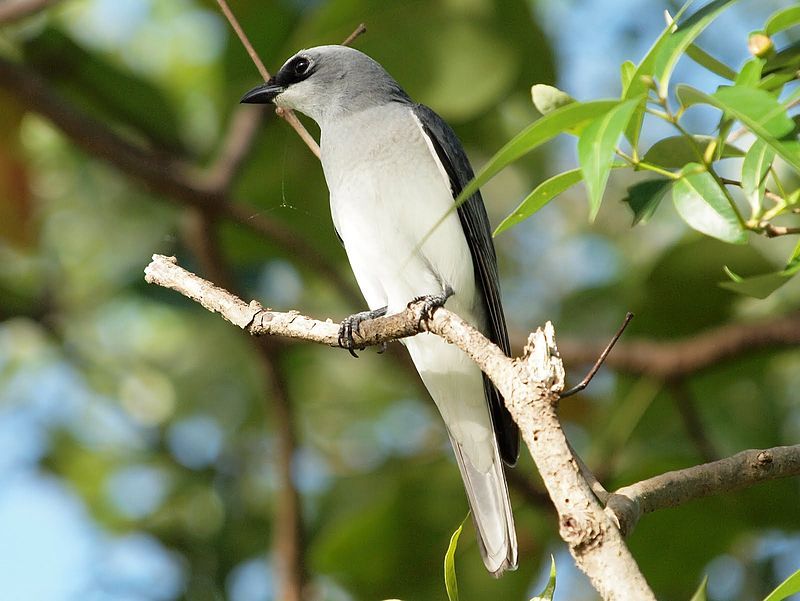
The white-bellied cuckoo shrike is a species of bird belonging to the Campephagidae family. This species can be found in several countries, including Australia, the Moluccas, New Guinea, and the Solomon Islands.
It is a medium-sized passerine bird, measuring approximately 18-20 cm in length. Its upperparts are mainly grey, while its underparts are white, hence its name. The face is black with a white stripe through the eye.
The wings are dark brown, barred with white, while the tail is white, barred with black. The white-bellied cuckoo shrike is usually found in the branches of trees, where they feed on a variety of insects and small fruits.
They are also known to form small flocks of up to 10 individuals and are usually quite vocal, often producing a variety of melodious calls.
During the breeding season, pairs of white-bellied cuckoo shrikes may nest in colonies in tree cavities, or in the dark recesses of hollow logs. This species is widespread and quite common in its range, so it is not considered to be threatened.
Despite this, it is still important to take measures to ensure that its habitat is not damaged or destroyed, as this would have a negative impact on the population of the white-bellied cuckoo shrike.
| Kingdom | Animalia |
| Phylum | Chordata |
| Class | Aves |
| Order | Passeriformes |
| Family | Campephagidae |
| Genus | Coracina |
| Species | C. papuensis |
25. Common Cicadabird
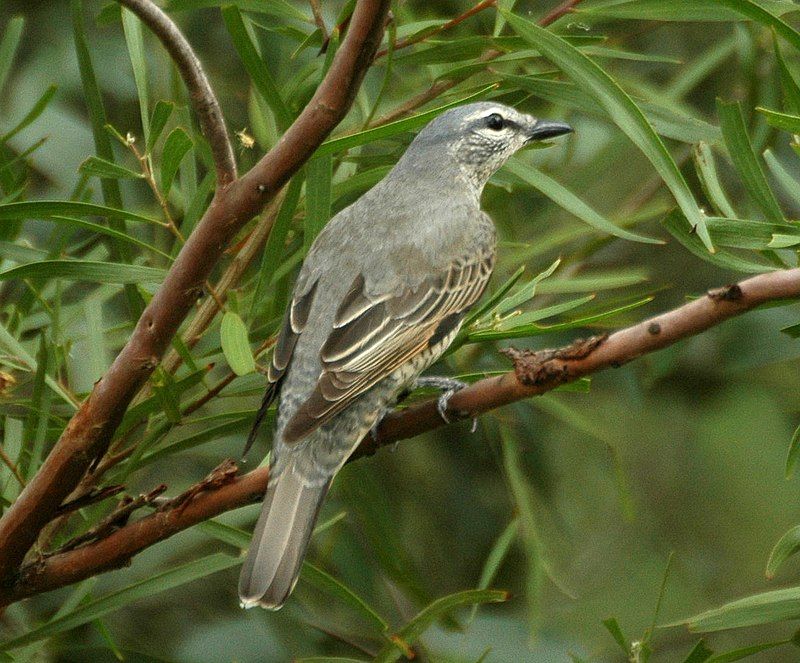
The common cicada bird, also known as the slender-billed cicada bird, is a species of bird that is part of the family Campephagidae. This species of bird is native to a wide range of areas, including Australia, Indonesia, New Guinea, and the Solomon Islands.
Its natural habitats are typically found in temperate forests, as well as subtropical or tropical moist lowland forests. This bird is known to forage for food in the understory of these habitats, where it preys on a variety of insects and other small creatures.
It is also known to breed in the same areas, usually in the months of August and September. The common cicada bird is considered to be a relatively common species, with a stable population size.
| Kingdom | Animalia |
| Phylum | Chordata |
| Class | Aves |
| Order | Passeriformes |
| Family | Campephagidae |
| Genus | Edolisoma |
| Species | E. tenuirostre |
26. Leaden Flycatcher
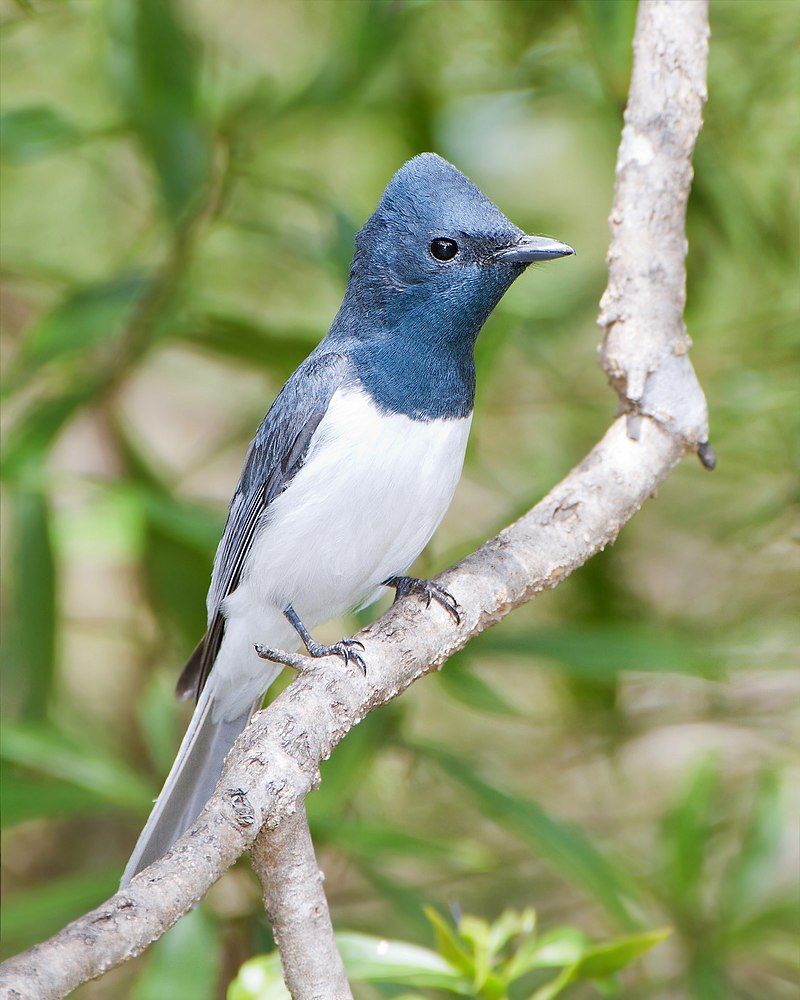
The leaden flycatcher is a species of bird, belonging to the family Monarchidae. It is a small bird, measuring around 15 cm in length. The male leaden flycatcher has a beautiful azure color, with white underparts.
The female leaden flycatcher has a leaden color on her head, mantle, and back, and a rufous color on her throat and breast. The leaden flycatcher is native to eastern and northern Australia, Indonesia, and Papua New Guinea.
It can be found in habitats such as woodlands, rainforests, and mangroves, where it searches for food. Its diet consists of small insects, including flies, beetles, and caterpillars.
The leaden flycatcher is a solitary bird, and it can often be seen perching on branches or flying in search of food. The leaden flycatcher is an important species in its range, as it helps to control insect populations.
Unfortunately, the leaden flycatcher is threatened by habitat loss and degradation, as well as predation from introduced species. Conservation efforts are needed to ensure that this species is not lost from its range.
| Kingdom | Animalia |
| Phylum | Chordata |
| Class | Aves |
| Order | Passeriformes |
| Family | Monarchidae |
| Genus | Myiagra |
| Species | M. rubecula |
27. Brown Honeyeater
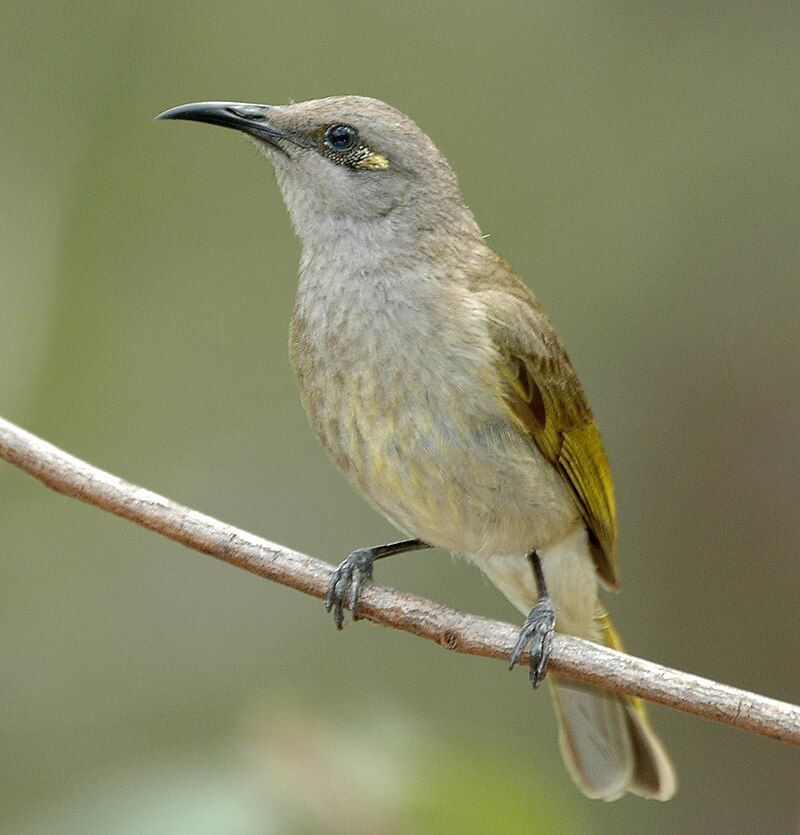
The brown honeyeater is a species of bird from the family Meliphagidae and is one of many birds belonging to the honeyeater group. Honeyeaters are known for their highly specialized tongues which are specifically adapted for nectar feeding.
Their brush-tipped tongues are perfect for collecting nectar from flowers and other sources of the sugary substance. This adaptation allows them to feed on a wide variety of plants and to easily reach into the depths of the flower.
Additionally, their tongues are able to collect pollen, which they then spread to other flowers as they feed. This pollination process is essential in maintaining the health of the ecosystem and the plants in it.
The brown honeyeater is one of many species of bird which rely on this adaptation to survive and thrive in the wild.
| Kingdom | Animalia |
| Phylum | Chordata |
| Class | Aves |
| Order | Passeriformes |
| Family | Meliphagidae |
| Genus | Lichmera |
| Species | L. indistincta |
28. Yellow-throated Miner
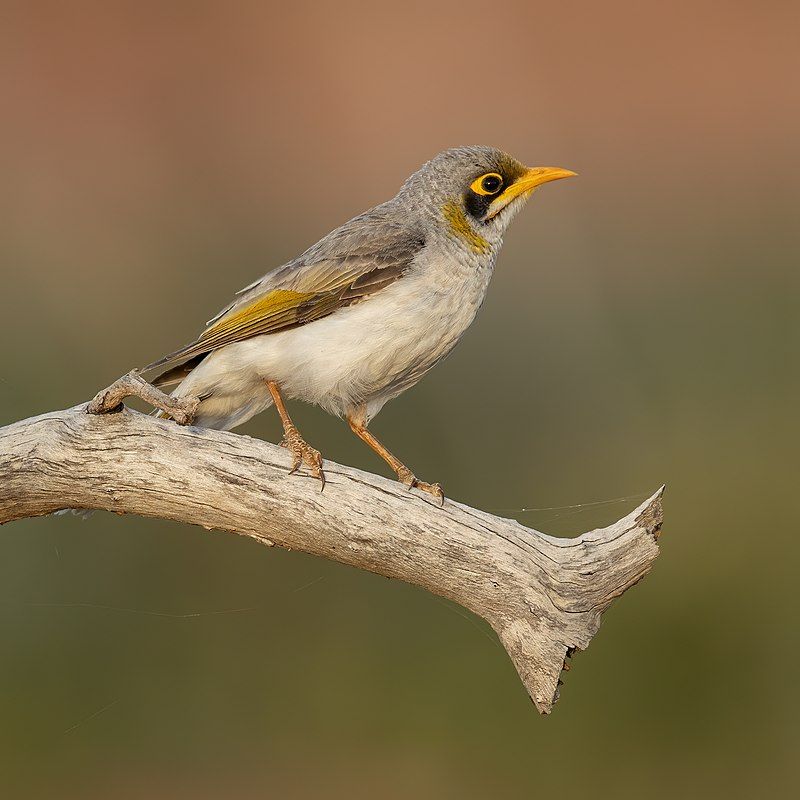
The yellow-throated miner is a species of colonial honeyeater that is found exclusively in Australia. It is a medium-sized bird, and its defining feature is its white rump which is easily identifiable in the wild, distinguishing it from other species of miners.
This white rump is what gives the yellow-throated miner its other name, the white-rumped miner. The yellow-throated miner is a social bird, usually living in small colonies or flocks.
Its diet consists of nectar, insects, and fruit, and it is known to forage for food in the middle and upper levels of trees. The bird’s habitat is typically dry woodlands and shrublands, although it is becoming increasingly rare in some parts of Australia due to habitat loss.
The yellow-throated miner is an important species for the environment, as it plays a crucial role in pollination and dispersing seeds. Its bright yellow throat also adds a splash of color to its environment.
This species is currently listed as Vulnerable on the IUCN Red List due to its decreasing population.
| Kingdom | Animalia |
| Phylum | Chordata |
| Class | Aves |
| Order | Passeriformes |
| Family | Meliphagidae |
| Genus | Manorina |
| Species | M. flavigula |
29. Little Woodswallow
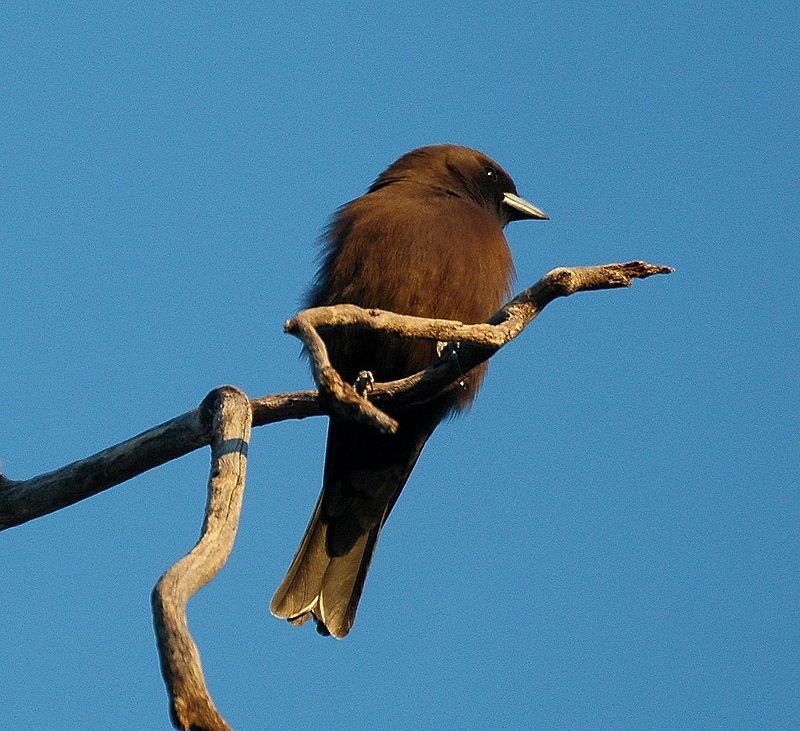
The little wood swallow is a species of bird that is found in many parts of mainland Australia, but it avoids certain regions. It shuns the driest deserts and stays away from the coastline within approximately 300 kilometers of the southern boundary.
However, it does have a preference for rugged terrain, particularly around inland mountain ranges. This bird is not evenly distributed across the entire continent but is found in patchy areas.
This is why it is important to consider the local terrain when looking for the little wood swallow. It is also important to note that it is found primarily in inland areas.
Therefore, if you are looking for the little wood swallow, it is best to look in rugged, inland terrain, away from the driest deserts and the southern coastline.
| Kingdom | Animalia |
| Phylum | Chordata |
| Class | Aves |
| Order | Passeriformes |
| Family | Artamidae |
| Genus | Artamus |
| Species | A. minor |
30. Black-faced Woodswallow
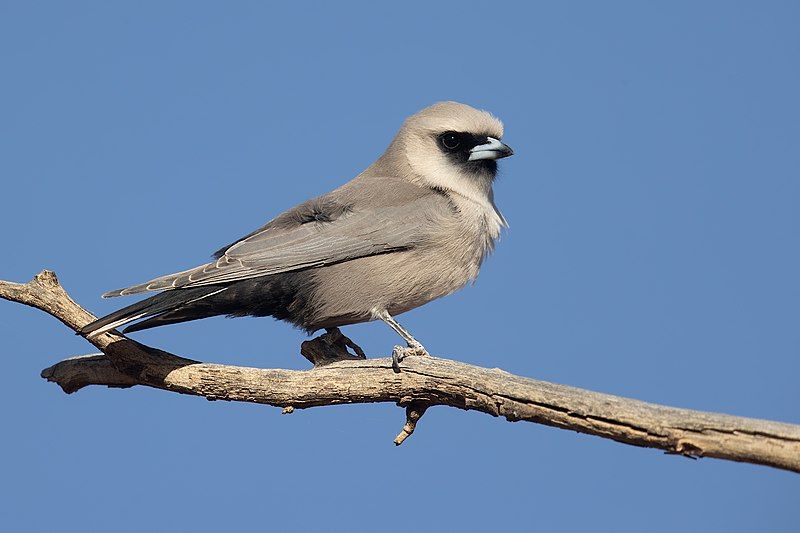
The black-faced wood swallow is a small bird species belonging to the genus Artamus, native to Australia, New Guinea, and the Sunda Islands, including Timor. It is 18–19 cm long and is characterized by its black face, and grey-brown wings and tail.
The black-faced wood swallow is the most widespread member of the family Artamidae, which also includes several other species of wood swallows. It is a highly adaptable species, capable of inhabiting a variety of habitats, including woodlands, grasslands, deserts, and urban areas.
The black-faced wood swallow is an omnivorous species, feeding on insects, fruits, and nectar. It is a highly social species, often gathering in large groups and forming large flocks during migration.
It is also known to form long-term pair bonds, with the same pair often returning to the same nesting site year after year.
| Kingdom | Animalia |
| Phylum | Chordata |
| Class | Aves |
| Order | Passeriformes |
| Family | Artamidae |
| Genus | Artamus |
| Species | A. cinereus |
31. White-throated Honeyeater
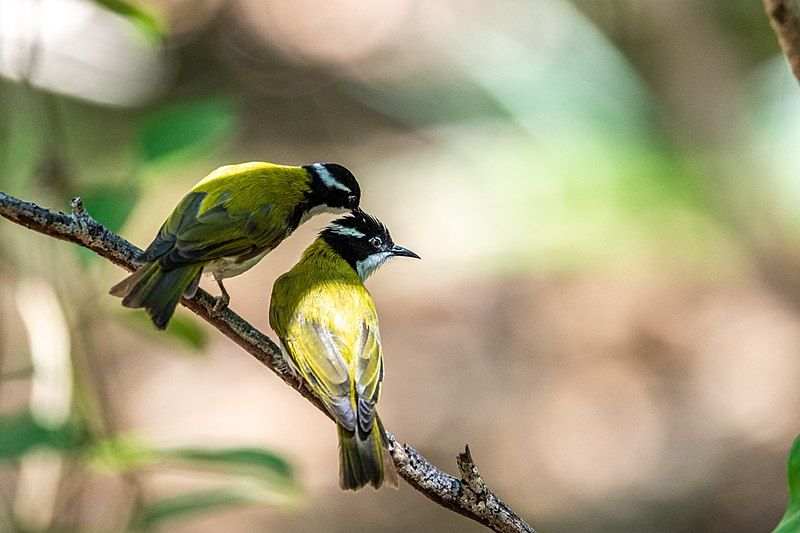
The white-throated honeyeater is a species of bird in the honeyeater family Meliphagidae. This species is native to New Guinea as well as eastern and northern Australia. On average, they measure to be 11.5 to 14.5 cm in length.
Their upper body is most commonly olive-green in color, while the underside is white. In addition, the head is black, and they have a white or pale blue patch over each eye. There is also a white stripe across the nape of the neck.
The white-throated honeyeater is a highly active species of bird. They are usually seen foraging in flocks, searching for insects, nectar, and small fruits. They are also known to feed on the ground, as well as in the trees.
They are found in a variety of habitats, from woodlands and forests to grasslands and shrublands. The white-throated honeyeater is an important species in its range, as they help to pollinate many different plants.
They are also beneficial to other species, as they help to disperse the seeds of various plants. These birds are not considered to be at risk of extinction, and they are currently listed as least concern on the IUCN Red List.
| Kingdom | Animalia |
| Phylum | Chordata |
| Class | Aves |
| Order | Passeriformes |
| Family | Meliphagidae |
| Genus | Melithreptus |
| Species | M. albogularis |
Conclusion
Kakadu National Park is a haven for a huge variety of bird species. It provides a unique habitat and is home to more than 280 species of birds. These species include a number of rare and threatened species, as well as some very special migratory species.
This park is a vital refuge for birds and thanks to its conservation efforts, it is possible for these species to thrive and survive in the wild.